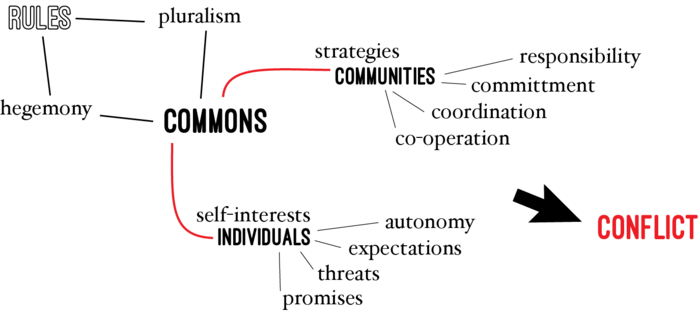Thesis Outline GdG: Difference between revisions
No edit summary |
No edit summary |
||
| Line 26: | Line 26: | ||
Individuals that are naturally moved by individual self-interest, are still able to commit to a game of tactical collaboration? | Individuals that are naturally moved by individual self-interest, are still able to commit to a game of tactical collaboration? | ||
How is this “game” interfacing with the existent law? | How is this “game” interfacing with the existent law? | ||
==NAME DROPPING== | |||
conflictual models of community existence | |||
on the role of order for groups of people | |||
which are the alternative to hegemonic order? | |||
acceptance of pluralism in/outside democracy. | |||
game theory | |||
common pool strategies. | |||
alternatives to the tragedy of the commons | |||
how people organize themselves and their actions in the sphere of the commons | |||
political paradigms, and exceptions: margins of improvisation within a regulated system. | |||
why democracy cannot work? | |||
on processes of immunization in community existence. | |||
the failure of participative processes | |||
on conflict and game theory | |||
on commitment and co-operation | |||
theory of interdependence | |||
individual strategic threats, promises, expectations | |||
how to achieve coordination? | |||
problems of conflict and collaboration: self-interest and common interests | |||
hegemonic nature of every social order | |||
==HOW?== | ==HOW?== | ||
Revision as of 08:56, 9 November 2017
WHAT?
“The people are multiple, the people are also divided” (Chantal Mouffe)
The thesis will be a research on conflictual models for community existence. In particular, I want to talk about alternatives to single hegemonic orders and implications of plural systems of rules and organizations. The sphere of the commons implies a rupture in the identity boundaries and expose individuals to a potential conflict. In this way, we can say that conflict is always a model of communities organizational structures. The minimization of the “struggle of the commons” through democratic, universalist and liberal models of participation cannot overcome the automatic conflictuality of individuals that forms a community. The processes of collaboration, bargain, discussion are processes by counter-hegemonic movements that transforms actively institutions and society.
I will look into a few neoliberal models that promotes “active” collaboration like : - sorting selection of political candidates - consensus & majority -
And research on different political paradigms or exceptions that includes margin of improvisation within a regulated system.
Conflictual participation is the best-case scenario for an encounter between people and society. It implies a surprise effect and impossibility to rely on previous standards. “What is interesting from conflictual participation is the critical engagement or the introduction of a post-disciplinary attitude, which can lead to a new production of knowledge”
Individuals that are naturally moved by individual self-interest, are still able to commit to a game of tactical collaboration? How is this “game” interfacing with the existent law?
NAME DROPPING
conflictual models of community existence on the role of order for groups of people which are the alternative to hegemonic order? acceptance of pluralism in/outside democracy. game theory common pool strategies. alternatives to the tragedy of the commons how people organize themselves and their actions in the sphere of the commons political paradigms, and exceptions: margins of improvisation within a regulated system. why democracy cannot work? on processes of immunization in community existence. the failure of participative processes on conflict and game theory on commitment and co-operation theory of interdependence individual strategic threats, promises, expectations how to achieve coordination? problems of conflict and collaboration: self-interest and common interests hegemonic nature of every social order
HOW?
DIVISION CHAPTERS
methods: I want to combine discursive and philosophical narrative with a series of comics that portrayed groups of people in different setups of the city. People in stations, streets, metro, supermarkets, traffic jams, suburbs etc. I will photograph those places and human dynamics from “above“, a distant and voyeristic point of view, an hegemonic position. The narrative of the strips will be an attempt to analyze the behavior of people in public space from their movements.
WHY?
Turn biopolitics into affirmative politics of communities. Look through the notion of public, commons and their specificities. How to create new spaces of freedom?

